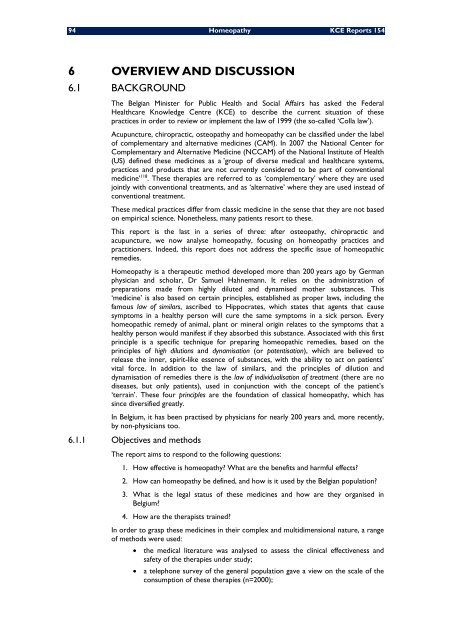Etat des lieux de l'homéopathie en Belgique - KCE
Etat des lieux de l'homéopathie en Belgique - KCE
Etat des lieux de l'homéopathie en Belgique - KCE
Create successful ePaper yourself
Turn your PDF publications into a flip-book with our unique Google optimized e-Paper software.
94 Homeopathy <strong>KCE</strong> Reports 154<br />
6 OVERVIEW AND DISCUSSION<br />
6.1 BACKGROUND<br />
The Belgian Minister for Public Health and Social Affairs has asked the Fe<strong>de</strong>ral<br />
Healthcare Knowledge C<strong>en</strong>tre (<strong>KCE</strong>) to <strong><strong>de</strong>s</strong>cribe the curr<strong>en</strong>t situation of these<br />
practices in or<strong>de</strong>r to review or implem<strong>en</strong>t the law of 1999 (the so-called ‘Colla law’).<br />
Acupuncture, chiropractic, osteopathy and homeopathy can be classified un<strong>de</strong>r the label<br />
of complem<strong>en</strong>tary and alternative medicines (CAM). In 2007 the National C<strong>en</strong>ter for<br />
Complem<strong>en</strong>tary and Alternative Medicine (NCCAM) of the National Institute of Health<br />
(US) <strong>de</strong>fined these medicines as a ’group of diverse medical and healthcare systems,<br />
practices and products that are not curr<strong>en</strong>tly consi<strong>de</strong>red to be part of conv<strong>en</strong>tional<br />
medicine’ 118 . These therapies are referred to as ‘complem<strong>en</strong>tary’ where they are used<br />
jointly with conv<strong>en</strong>tional treatm<strong>en</strong>ts, and as ‘alternative’ where they are used instead of<br />
conv<strong>en</strong>tional treatm<strong>en</strong>t.<br />
These medical practices differ from classic medicine in the s<strong>en</strong>se that they are not based<br />
on empirical sci<strong>en</strong>ce. Nonetheless, many pati<strong>en</strong>ts resort to these.<br />
This report is the last in a series of three: after osteopathy, chiropractic and<br />
acupuncture, we now analyse homeopathy, focusing on homeopathy practices and<br />
practitioners. In<strong>de</strong>ed, this report does not address the specific issue of homeopathic<br />
remedies.<br />
Homeopathy is a therapeutic method <strong>de</strong>veloped more than 200 years ago by German<br />
physician and scholar, Dr Samuel Hahnemann. It relies on the administration of<br />
preparations ma<strong>de</strong> from highly diluted and dynamised mother substances. This<br />
‘medicine’ is also based on certain principles, established as proper laws, including the<br />
famous law of similars, ascribed to Hippocrates, which states that ag<strong>en</strong>ts that cause<br />
symptoms in a healthy person will cure the same symptoms in a sick person. Every<br />
homeopathic remedy of animal, plant or mineral origin relates to the symptoms that a<br />
healthy person would manifest if they absorbed this substance. Associated with this first<br />
principle is a specific technique for preparing homeopathic remedies, based on the<br />
principles of high dilutions and dynamisation (or pot<strong>en</strong>tisation), which are believed to<br />
release the inner, spirit-like ess<strong>en</strong>ce of substances, with the ability to act on pati<strong>en</strong>ts’<br />
vital force. In addition to the law of similars, and the principles of dilution and<br />
dynamisation of remedies there is the law of individualisation of treatm<strong>en</strong>t (there are no<br />
diseases, but only pati<strong>en</strong>ts), used in conjunction with the concept of the pati<strong>en</strong>t’s<br />
‘terrain’. These four principles are the foundation of classical homeopathy, which has<br />
since diversified greatly.<br />
In Belgium, it has be<strong>en</strong> practised by physicians for nearly 200 years and, more rec<strong>en</strong>tly,<br />
by non-physicians too.<br />
6.1.1 Objectives and methods<br />
The report aims to respond to the following questions:<br />
1. How effective is homeopathy? What are the b<strong>en</strong>efits and harmful effects?<br />
2. How can homeopathy be <strong>de</strong>fined, and how is it used by the Belgian population?<br />
3. What is the legal status of these medicines and how are they organised in<br />
Belgium?<br />
4. How are the therapists trained?<br />
In or<strong>de</strong>r to grasp these medicines in their complex and multidim<strong>en</strong>sional nature, a range<br />
of methods were used:<br />
• the medical literature was analysed to assess the clinical effectiv<strong>en</strong>ess and<br />
safety of the therapies un<strong>de</strong>r study;<br />
• a telephone survey of the g<strong>en</strong>eral population gave a view on the scale of the<br />
consumption of these therapies (n=2000);

















